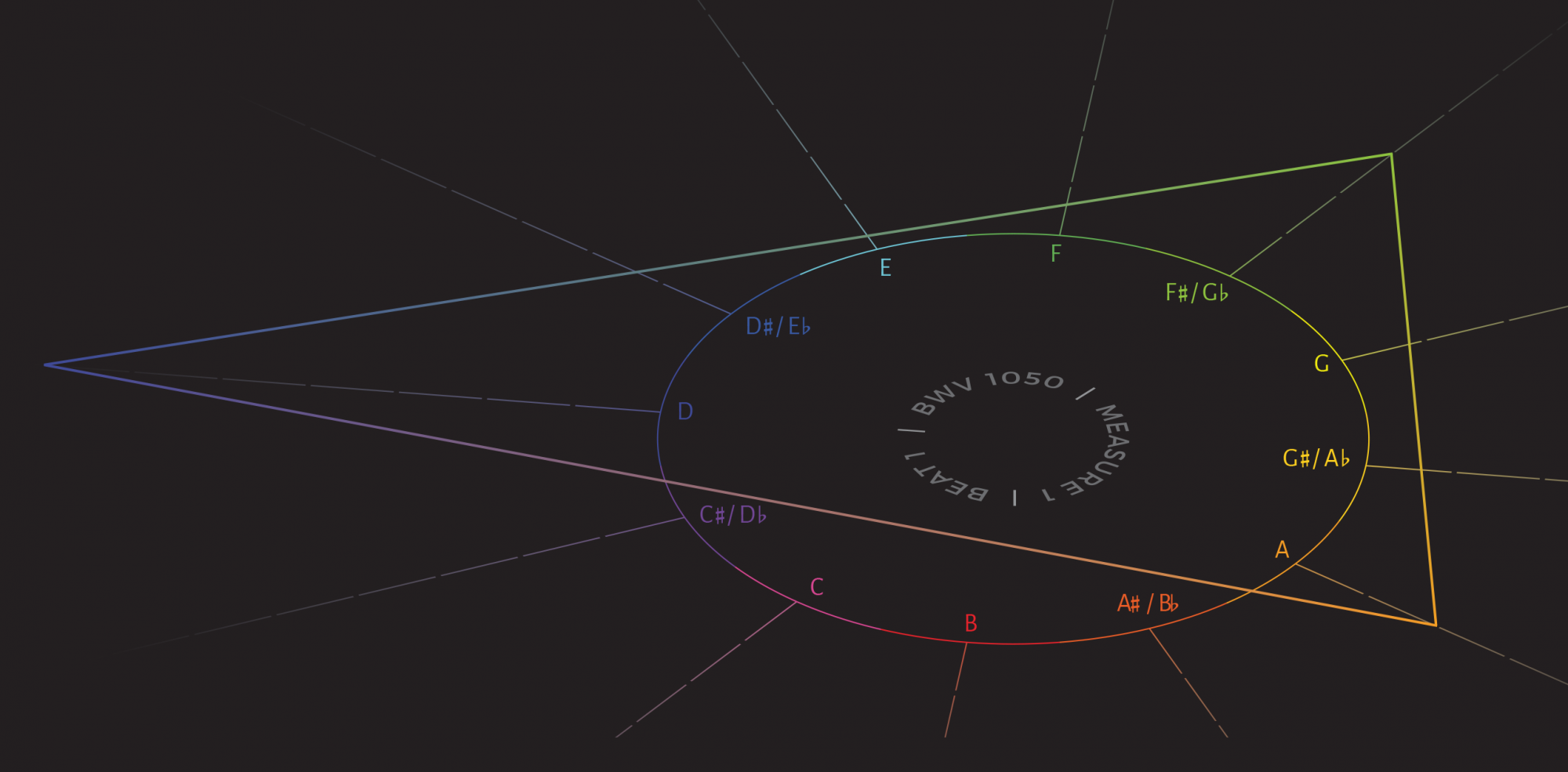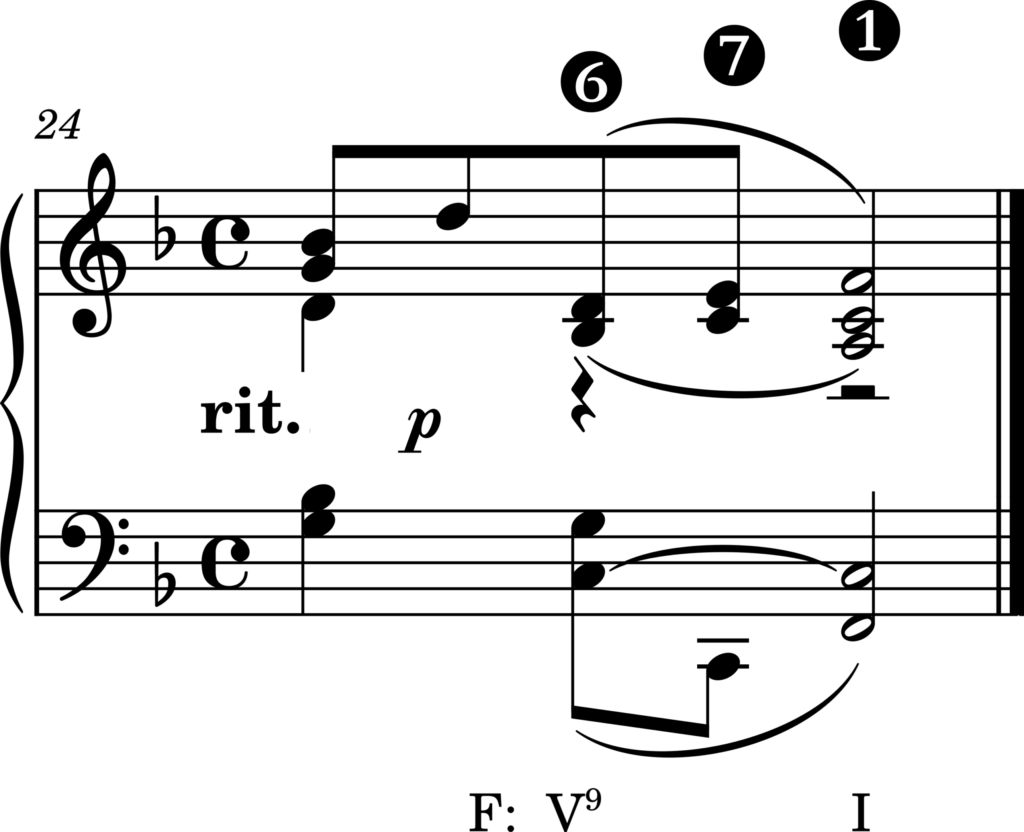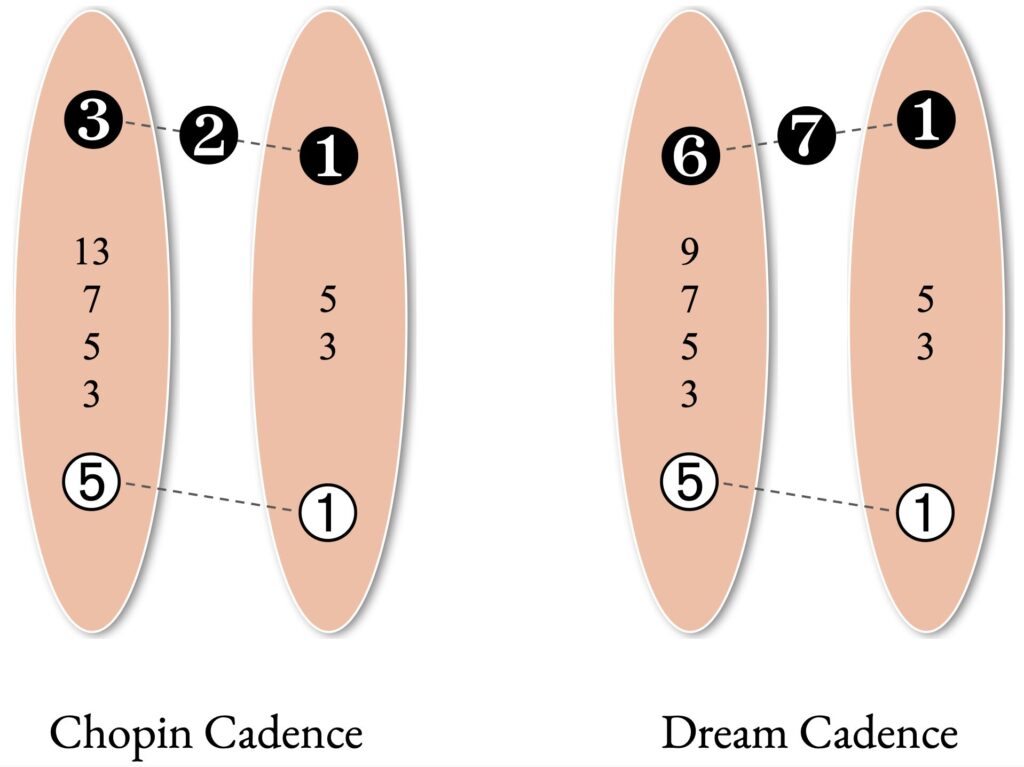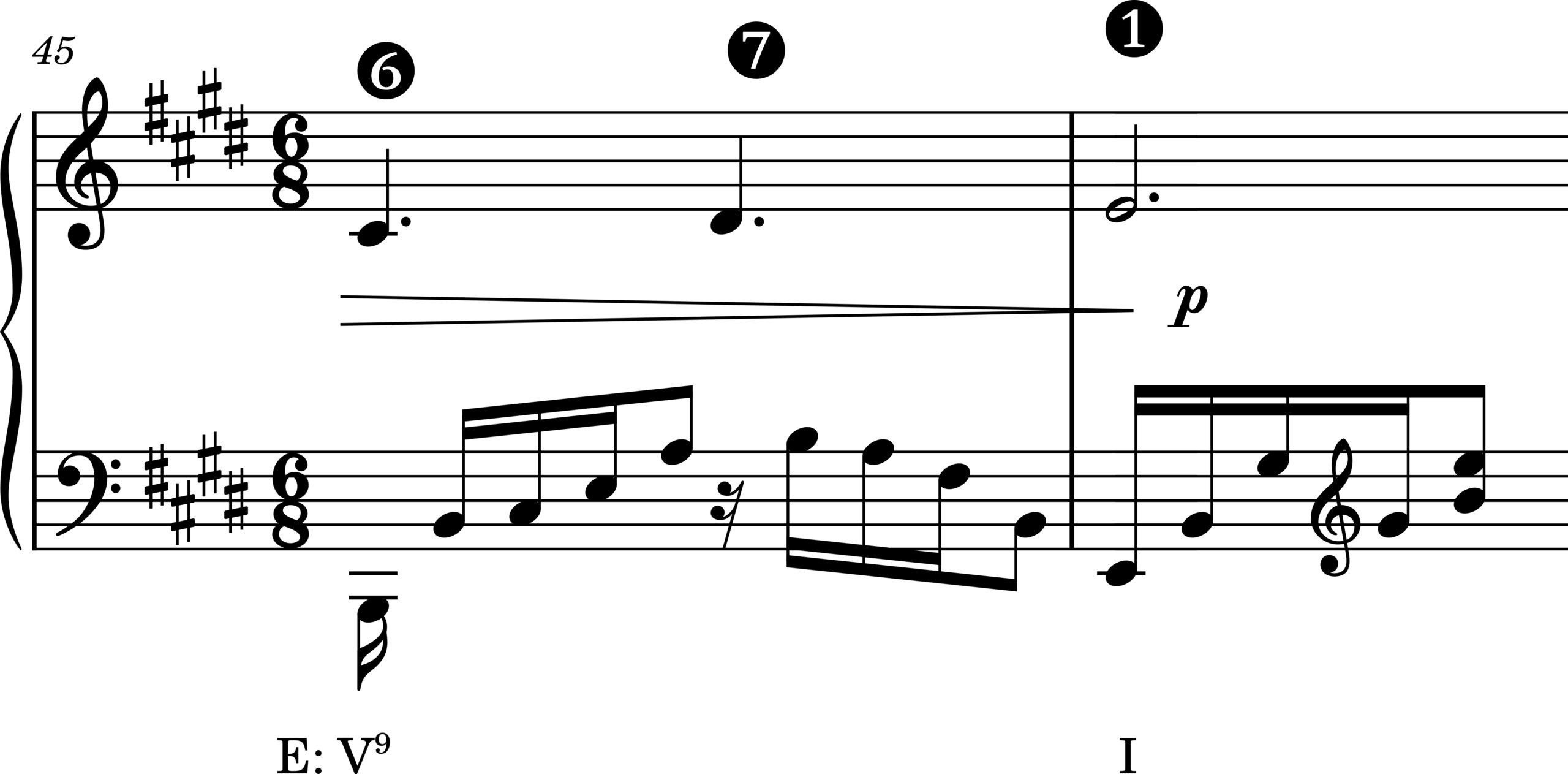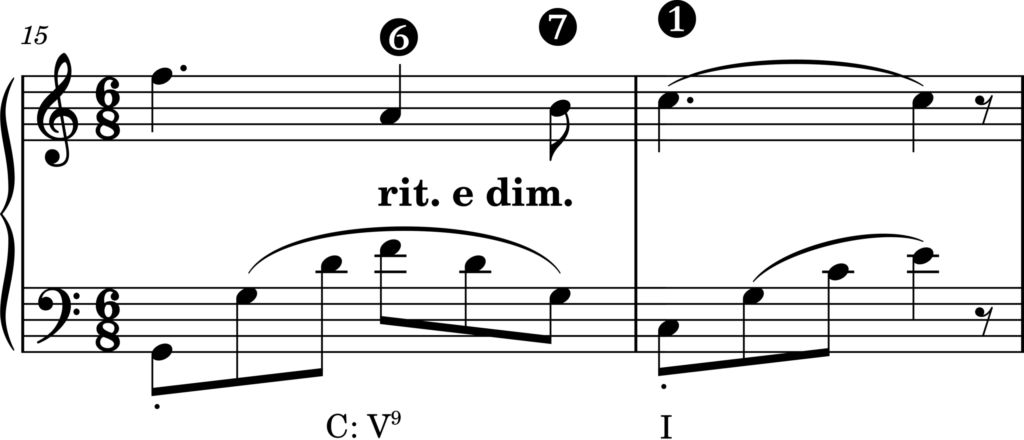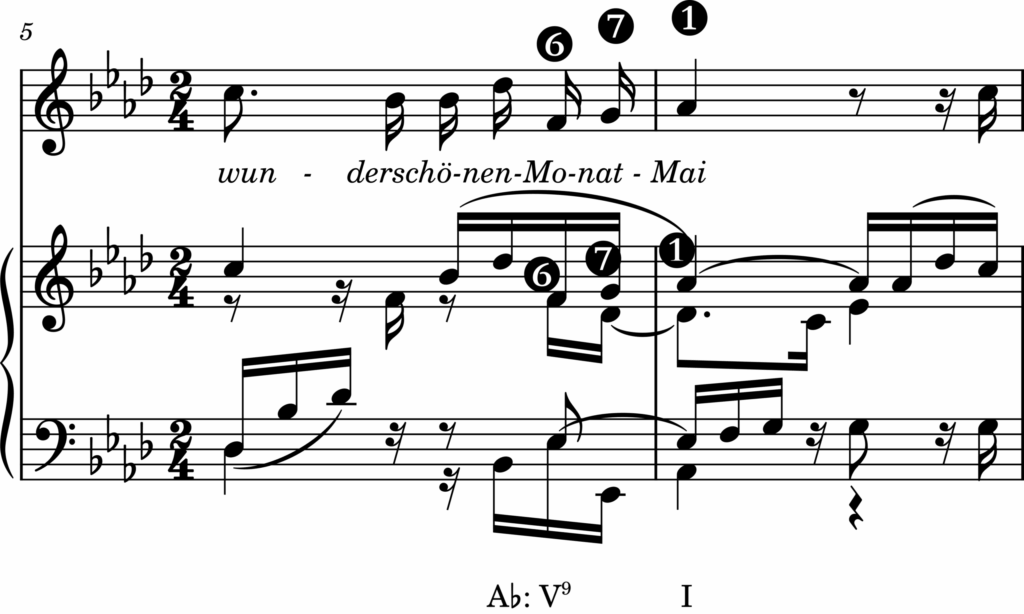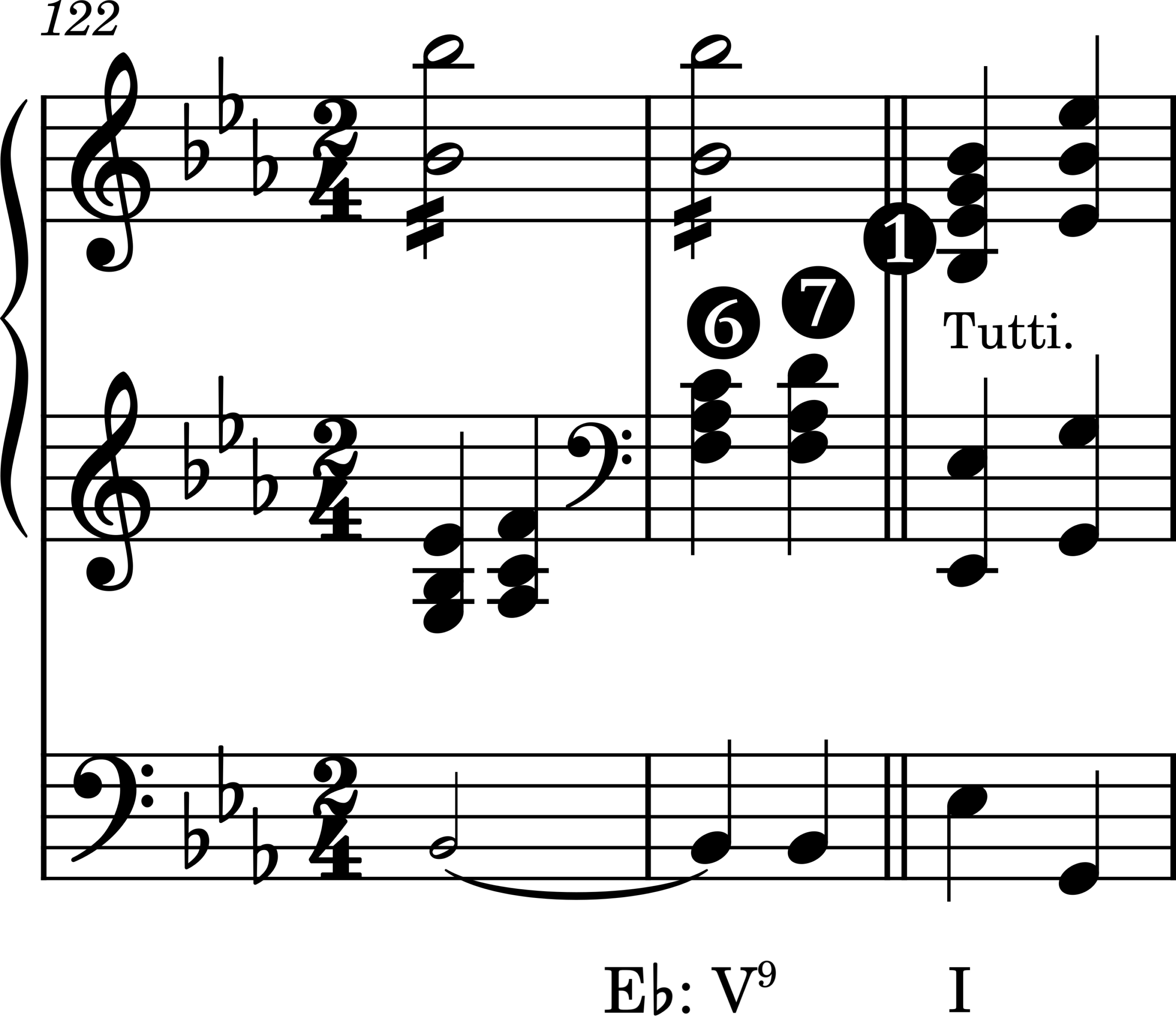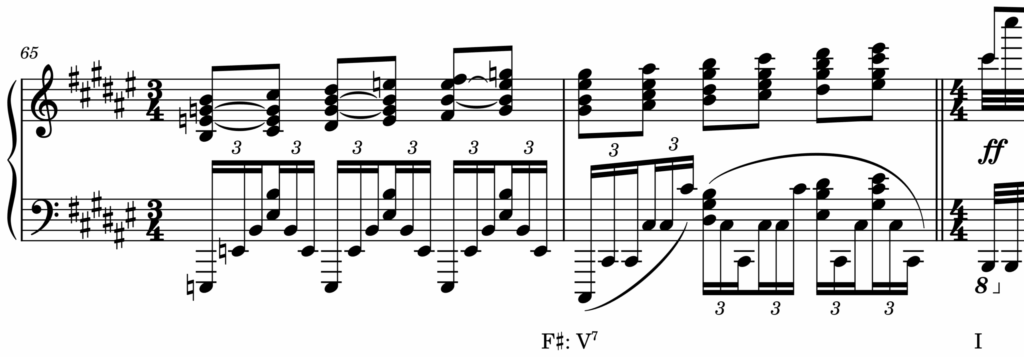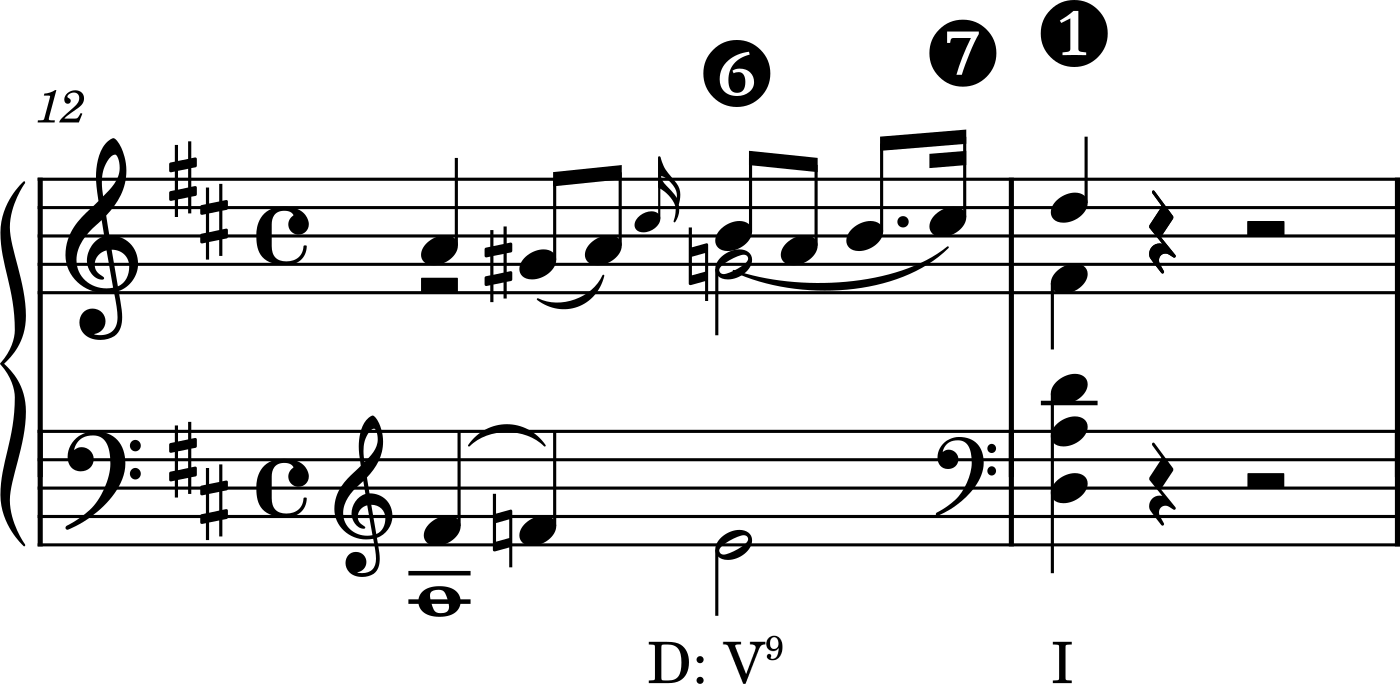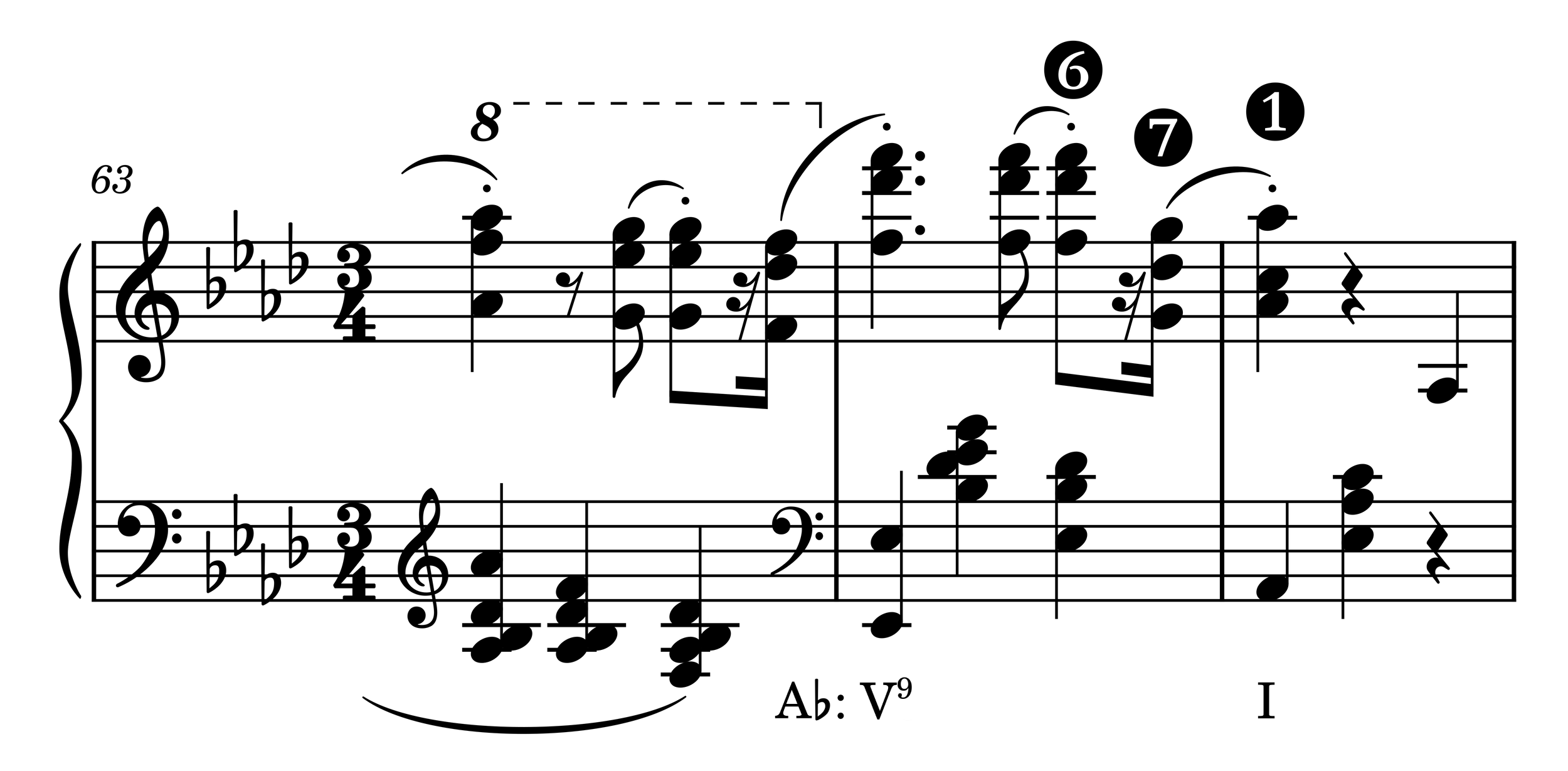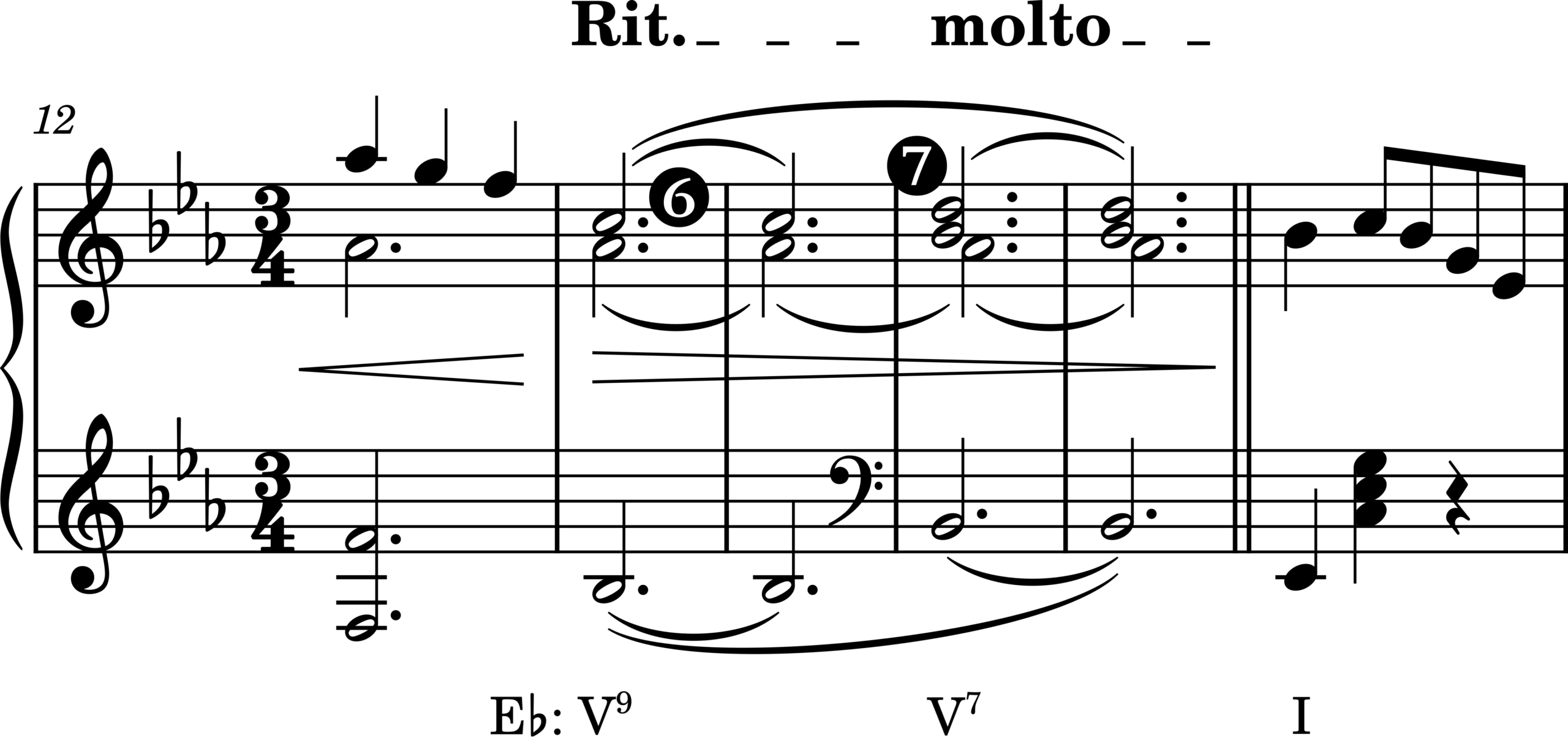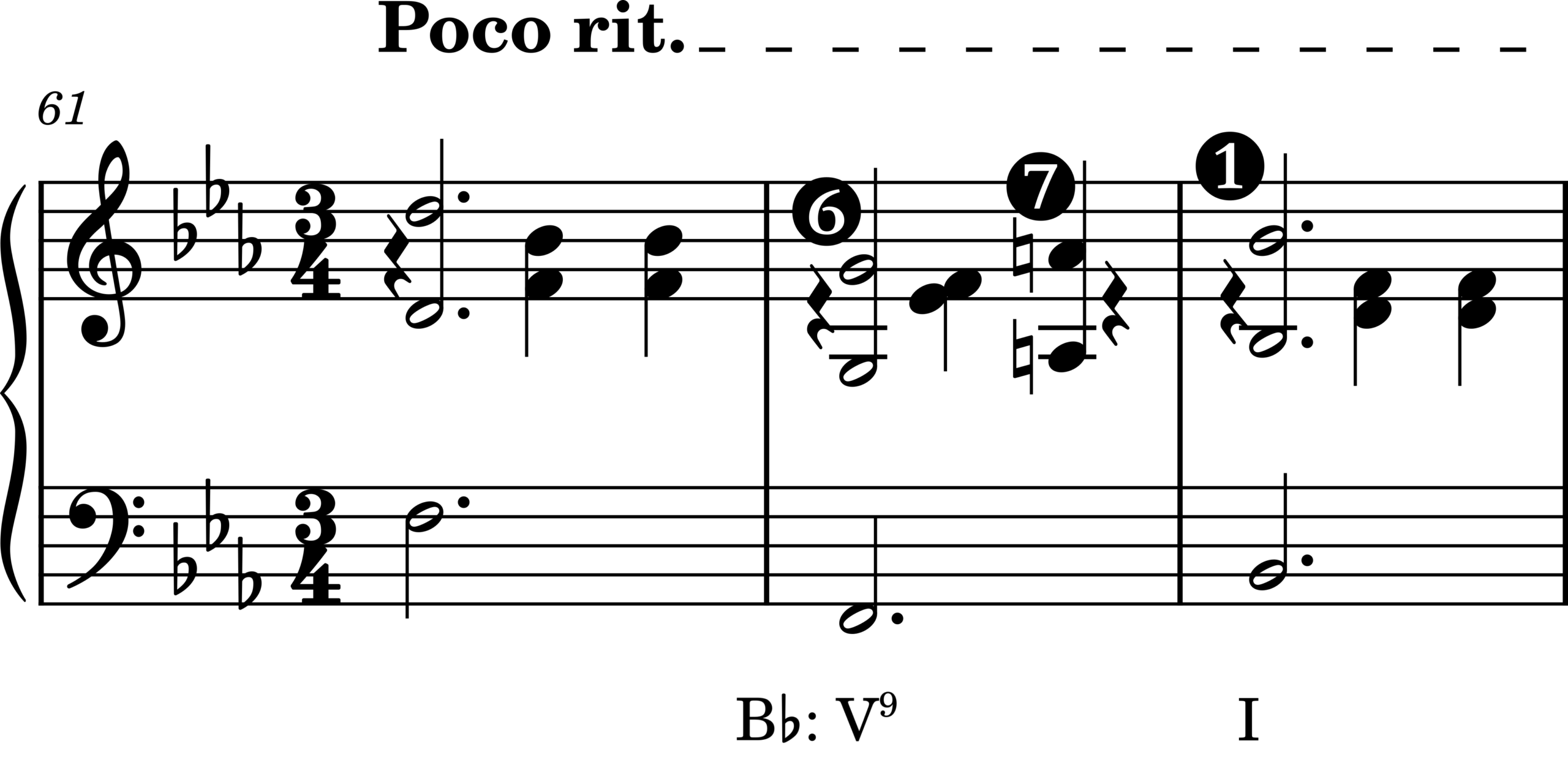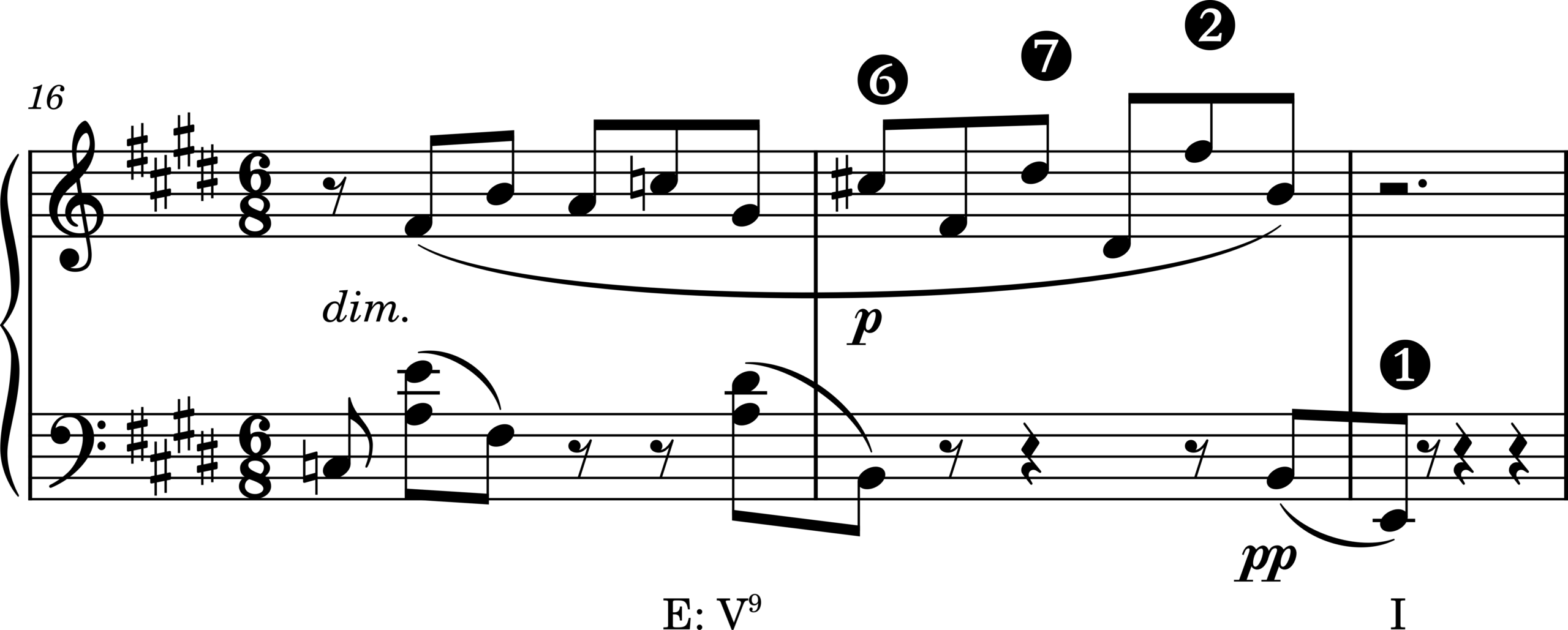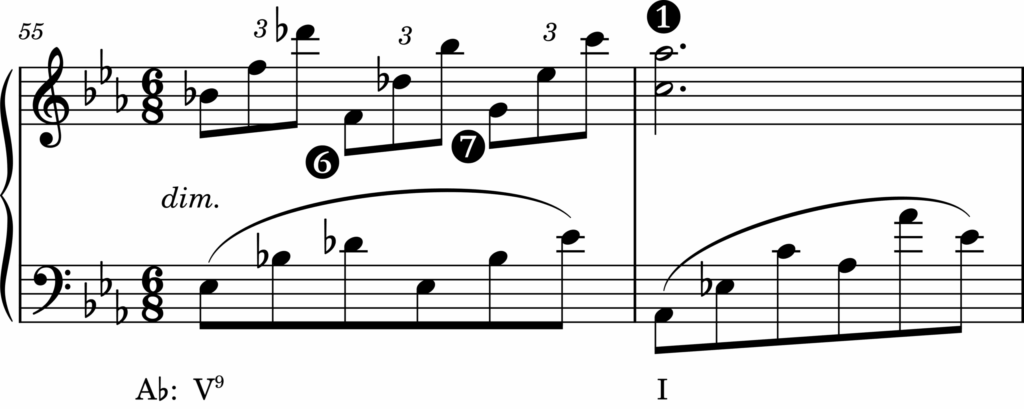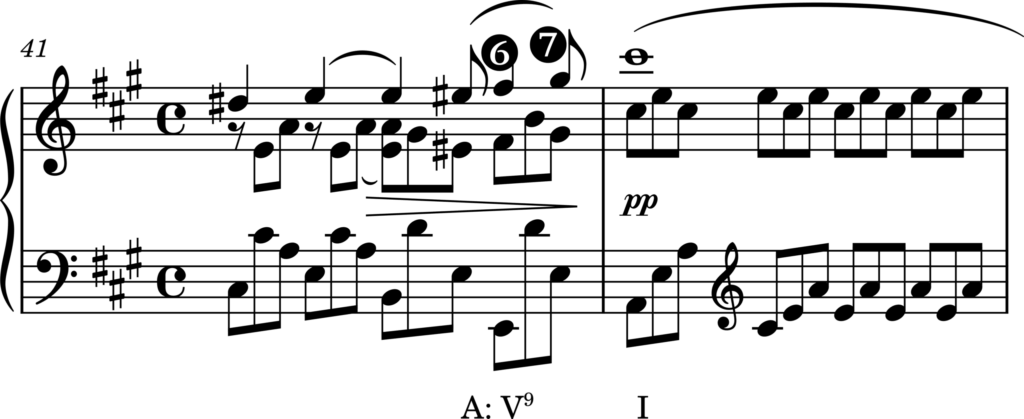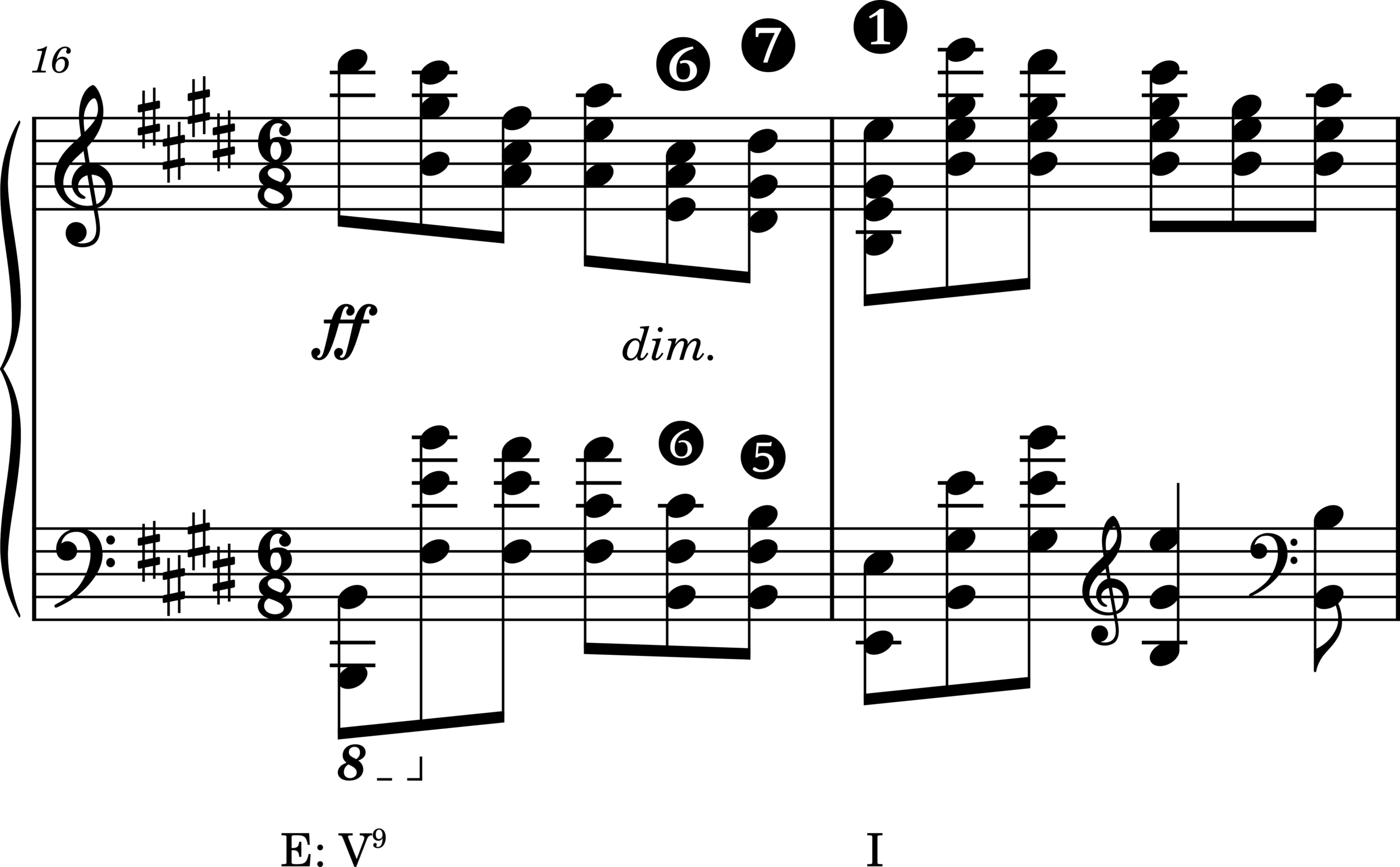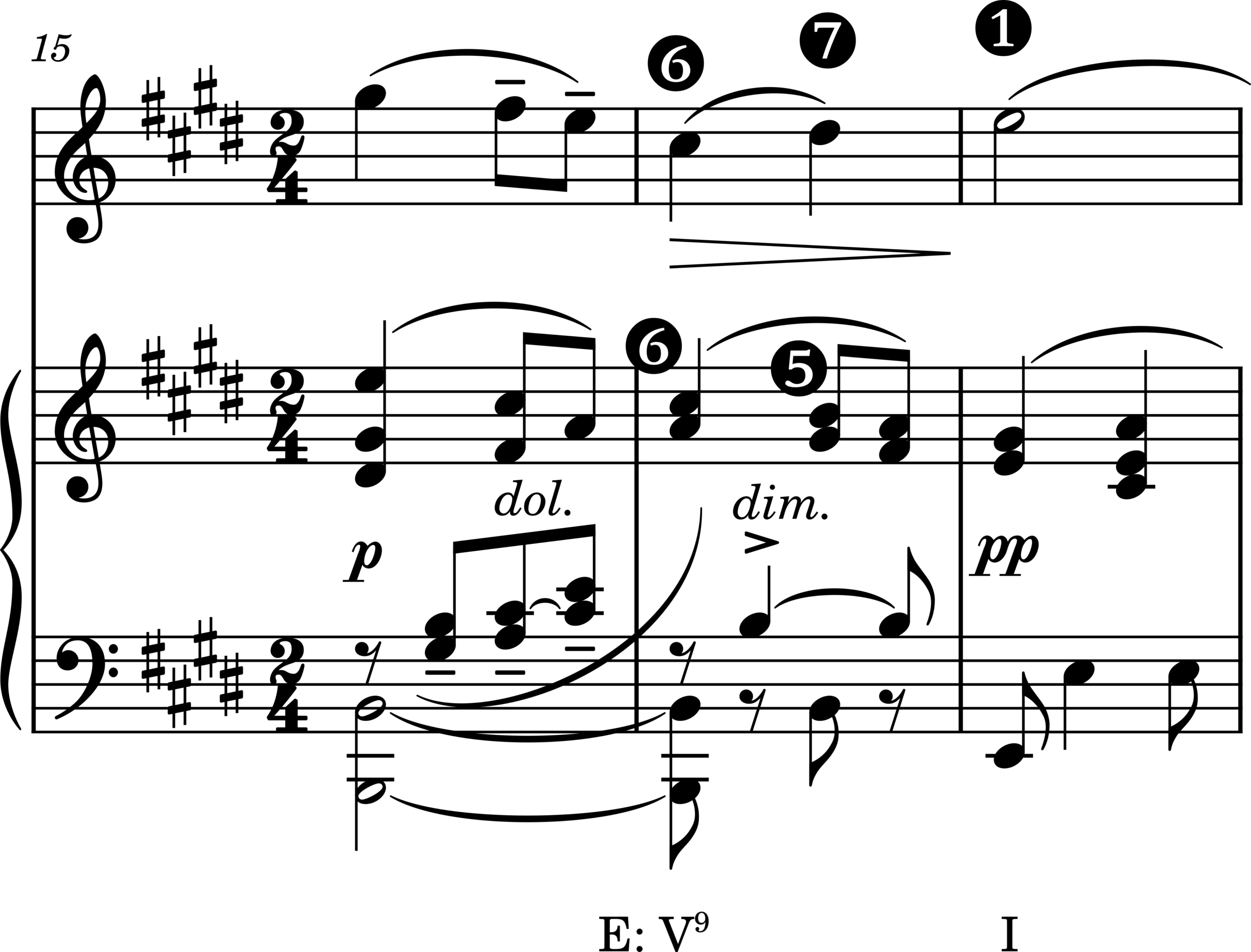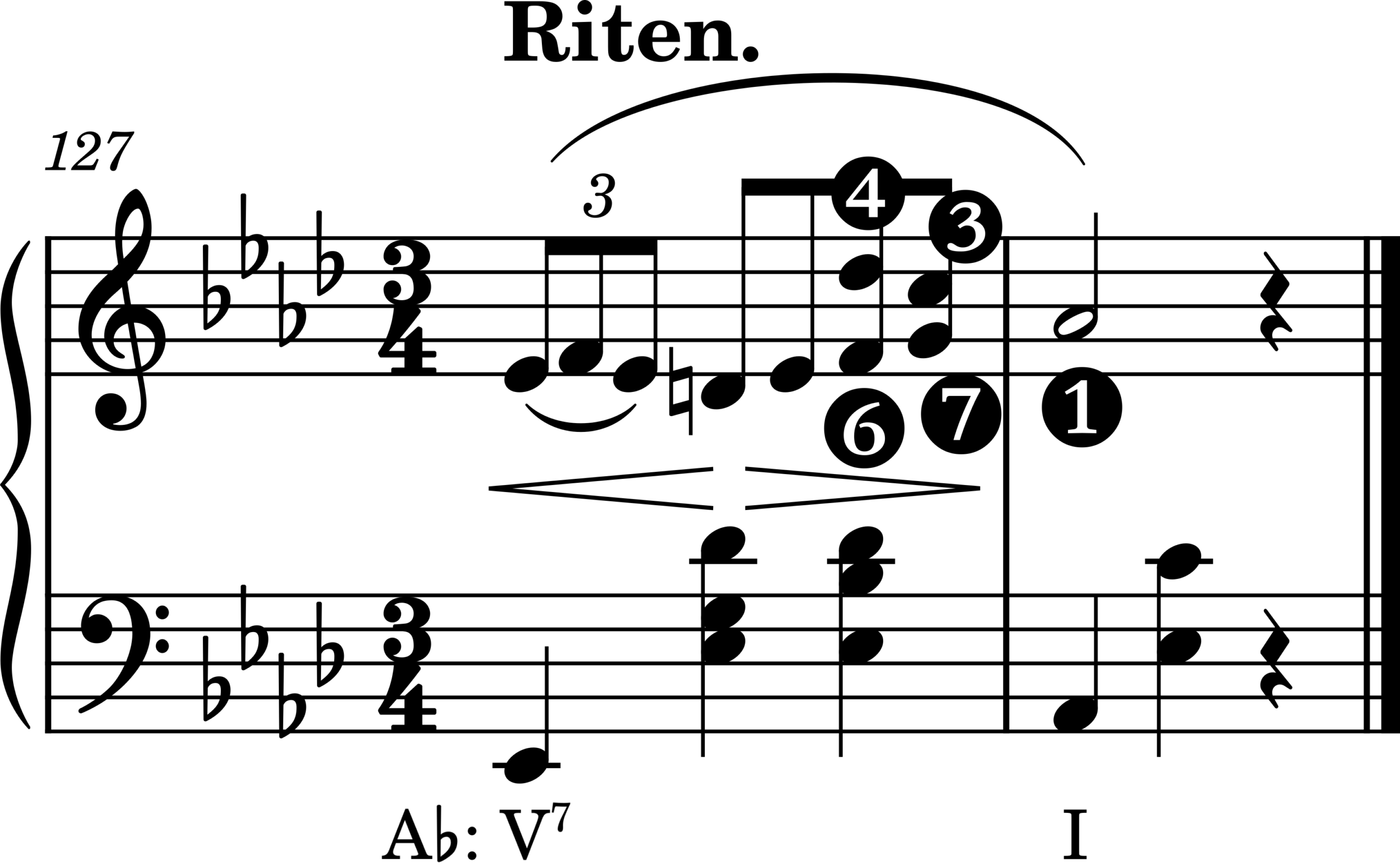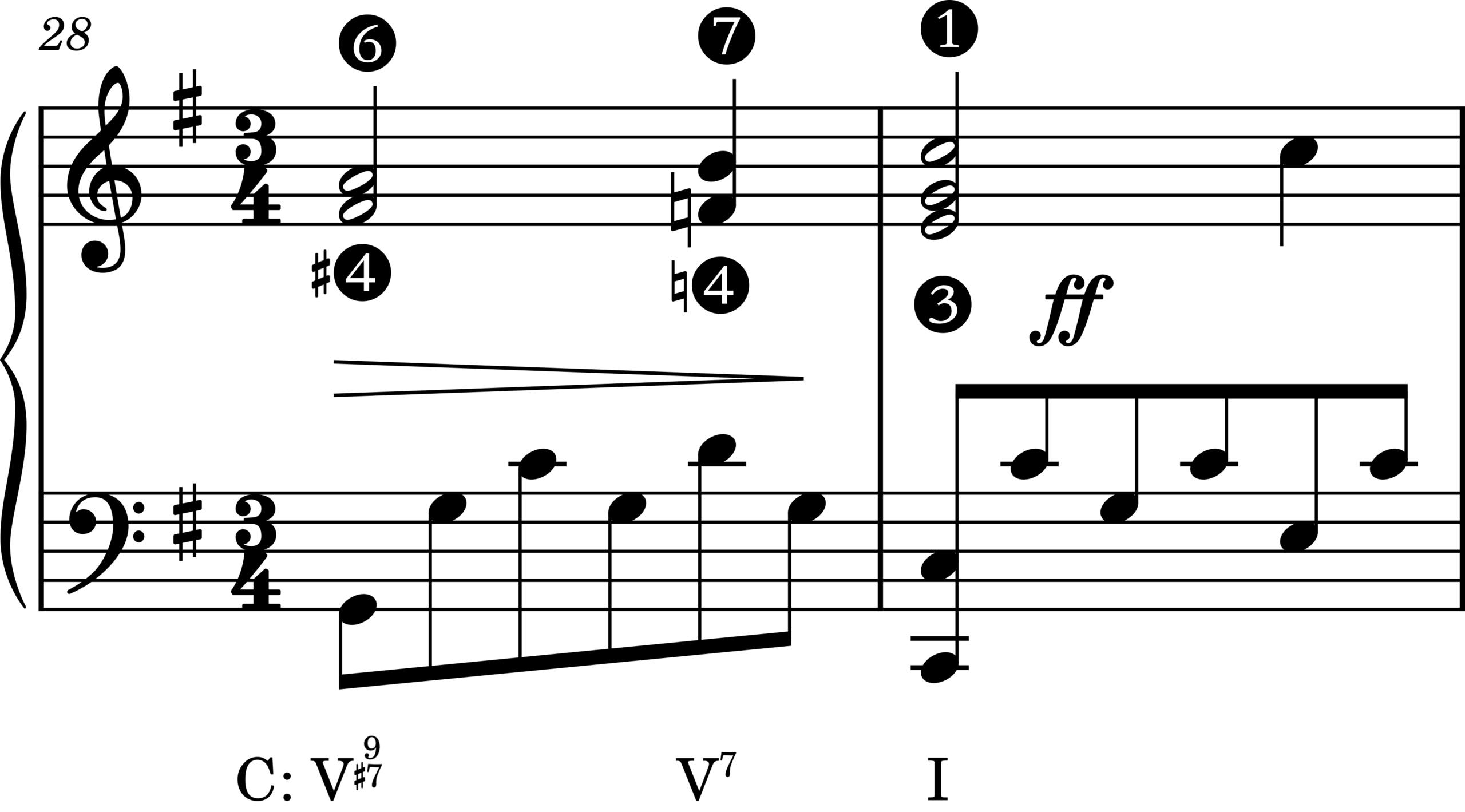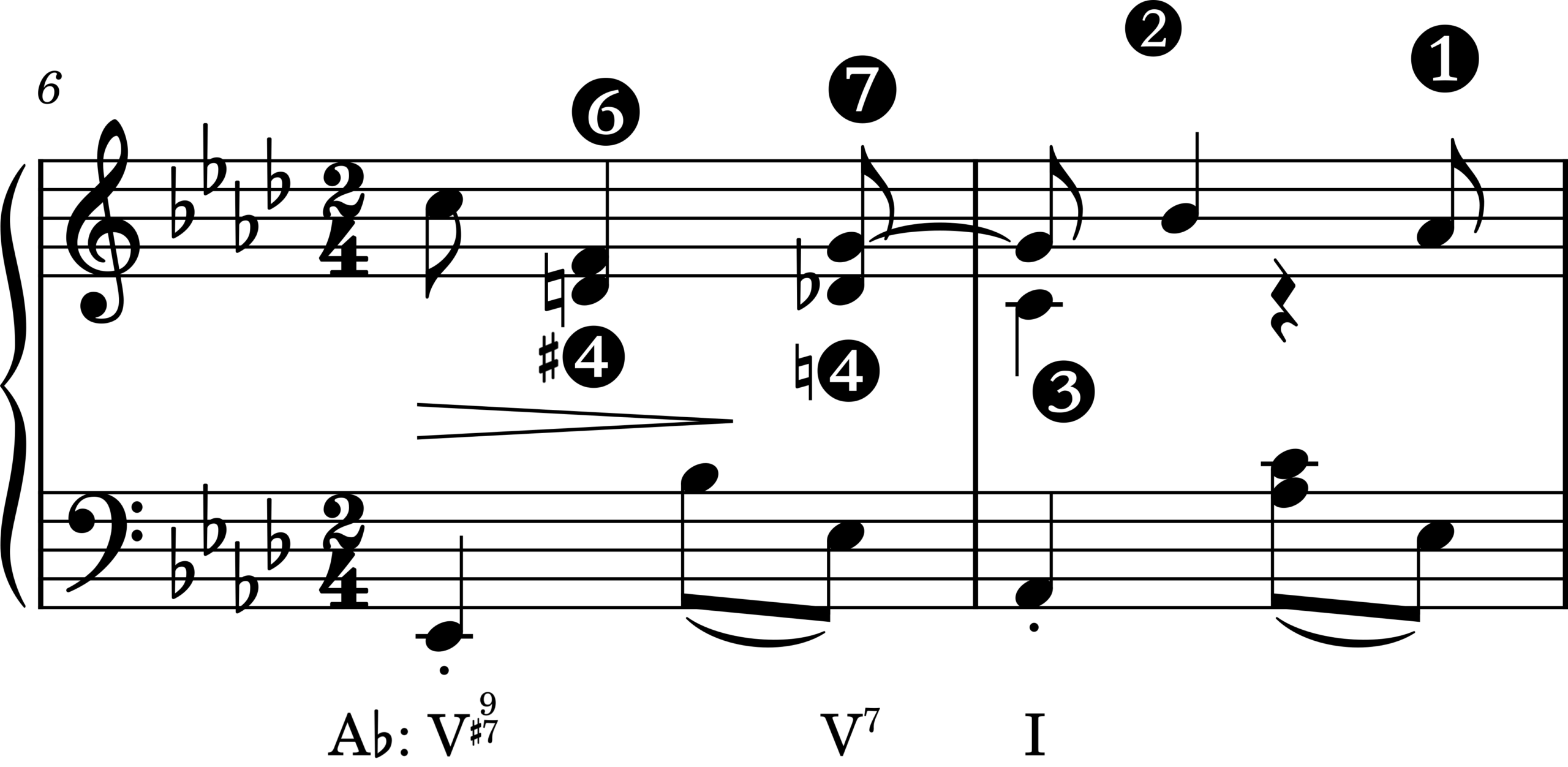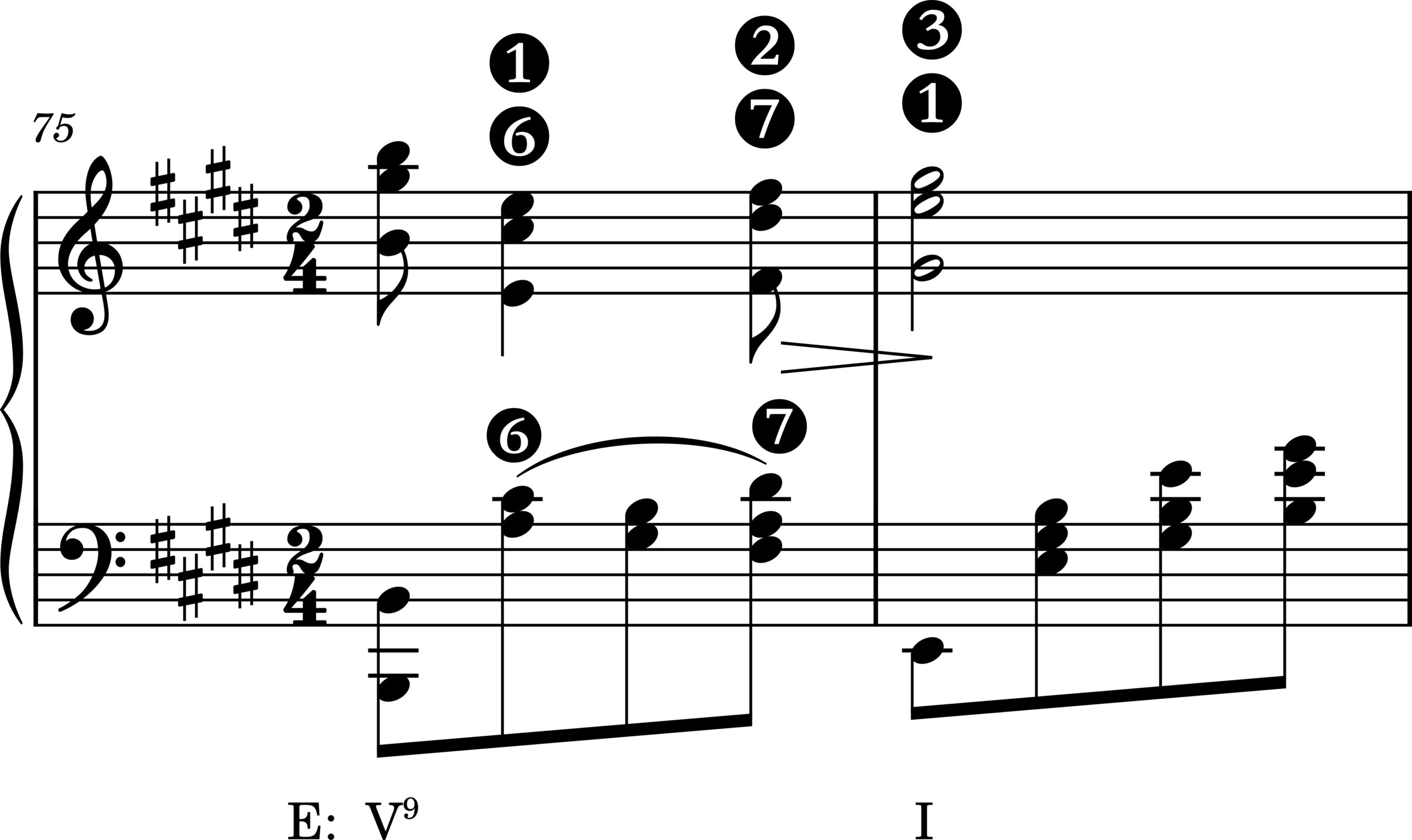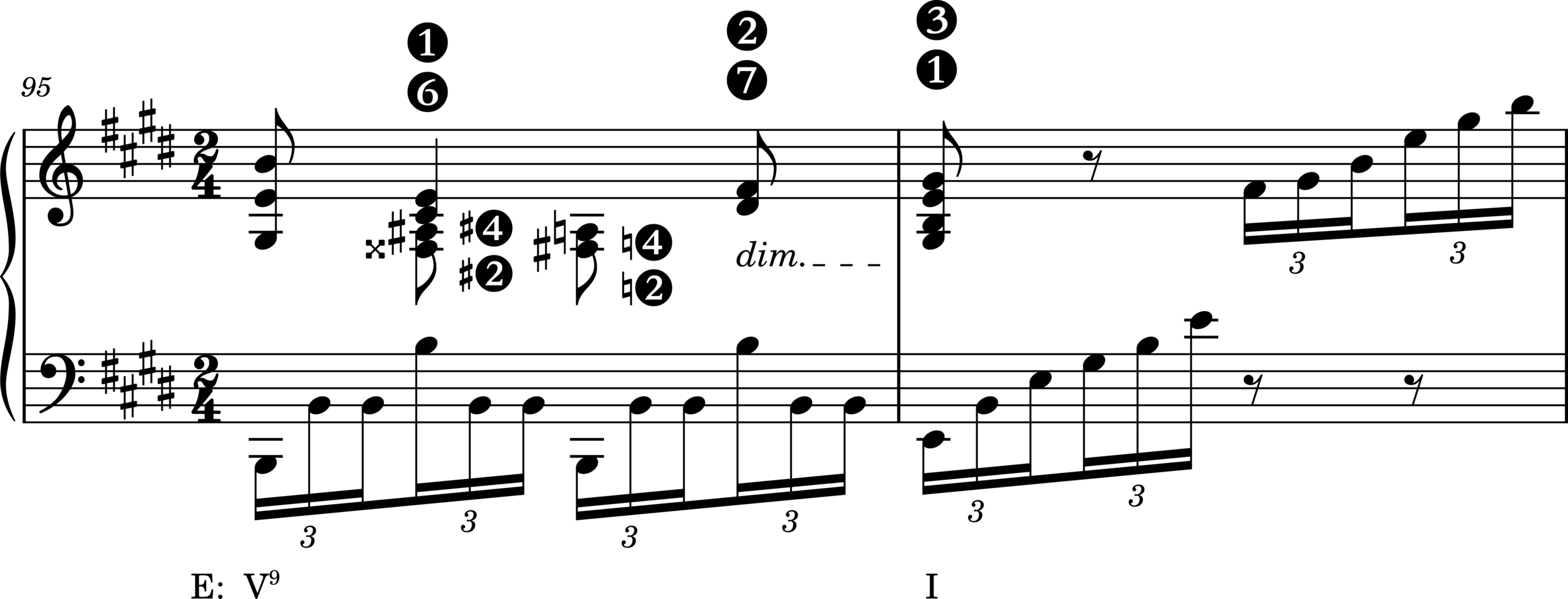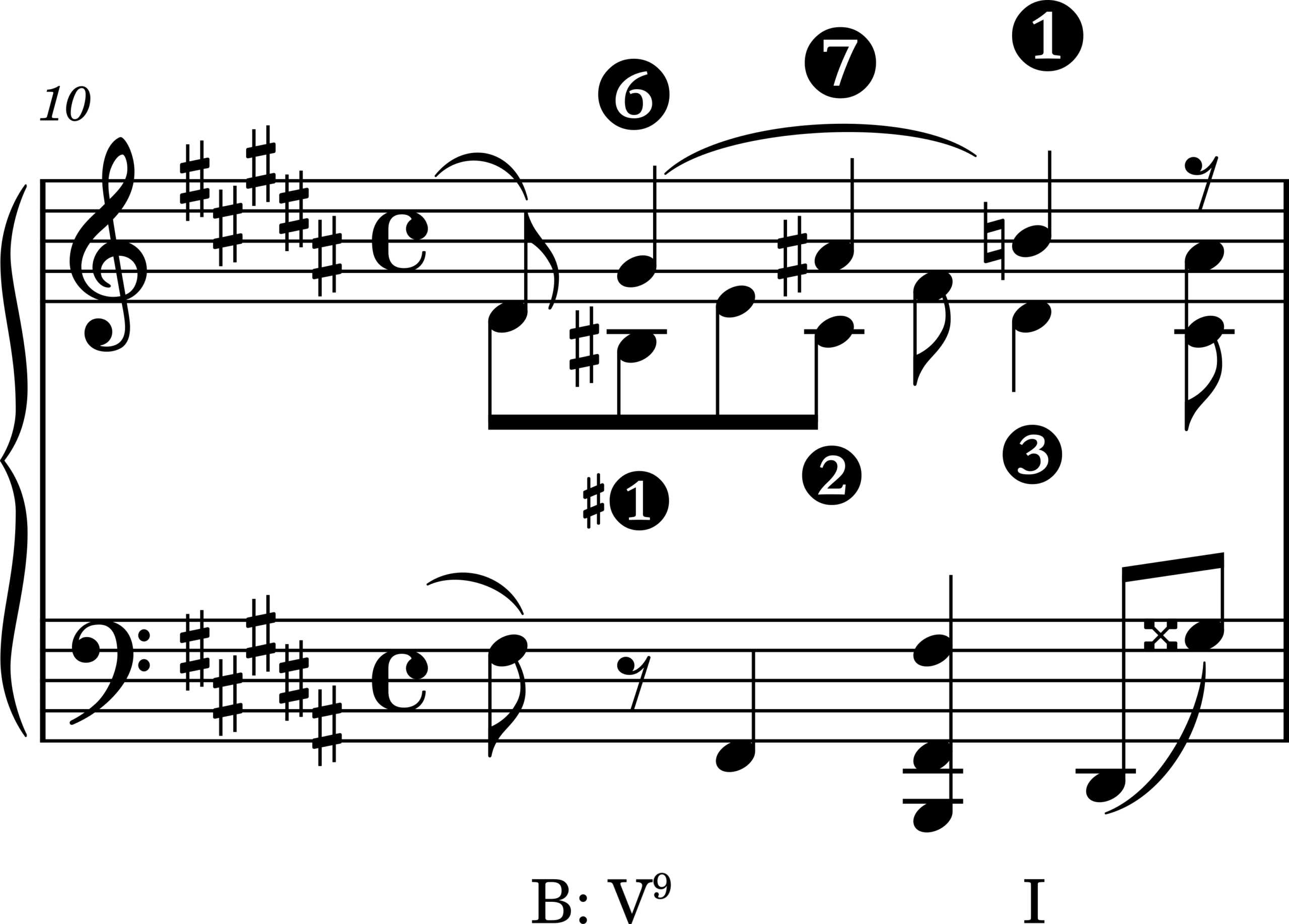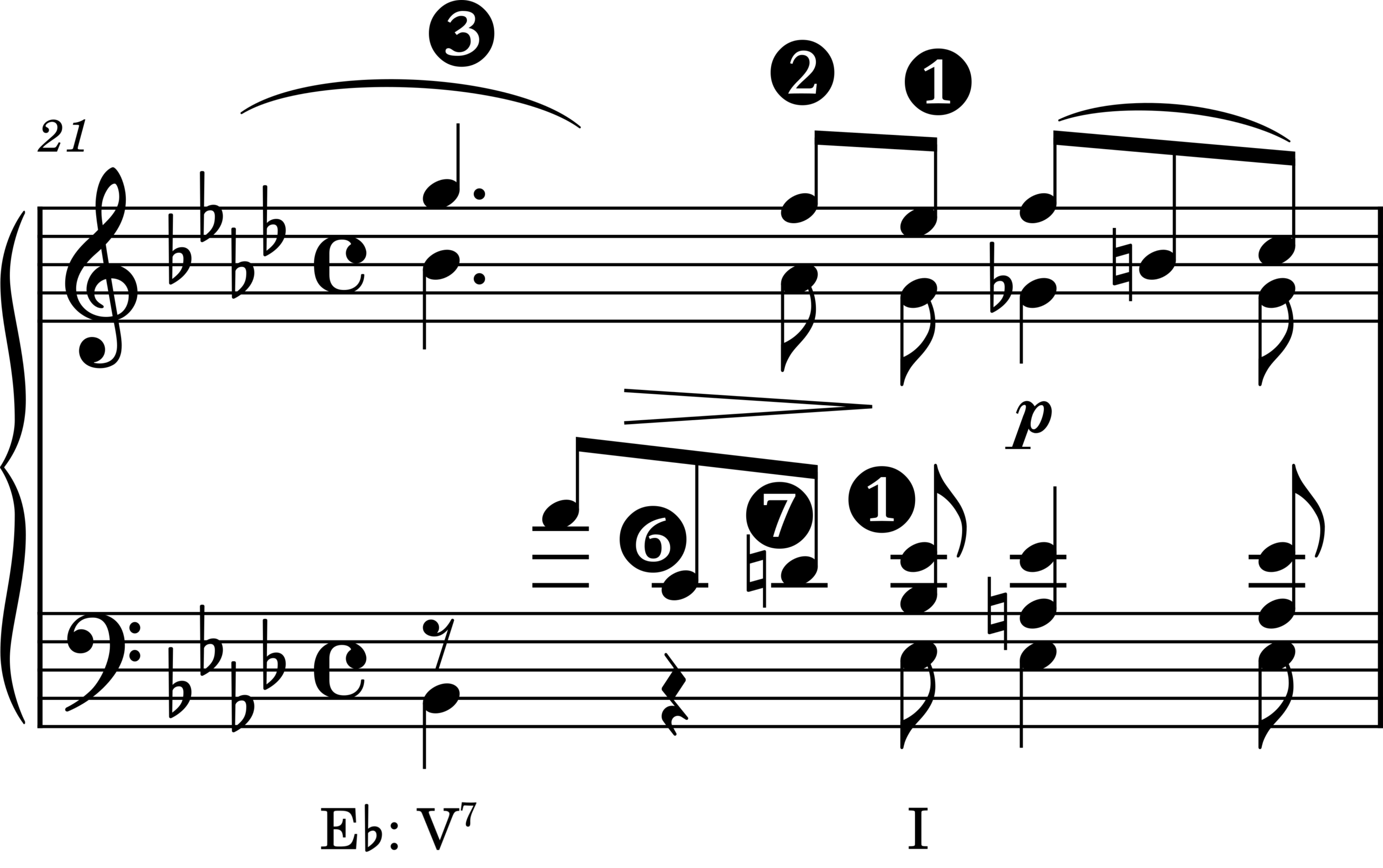Julien Despois
Abstract
This article describes a cadential phenomenon characterized by a dominant ninth chord whose ninth resolves through an unconventional
$$\hat{6}$$–$$\hat{7}$$–$$\hat{1}$$ motif. Termed the Dream Cadence in tribute to Robert Schumann’s “Träumerei,” this device is exclusive to the major mode where it is employed to create a calm and delicate atmosphere. I aim to shed light on the defining features of this cadence, its common variations, and the possibilities it offers for contrapuntal elaboration. To do so, I explore its use in compositions from the Romantic Era through an analysis of the music of various composers, including Frédéric Chopin, John Field, and Alexander Scriabin.
View PDF
Return to Volume 38
Keywords and Phrases: Romantic, cadence, dominant ninth chord, ascending ninth, “Träumerei”
Introduction: Romantic Cadences
During the Romantic Era, the search for novel sonorities led to the more frequent use of extended harmonies, including the seventh, ninth, and thirteenth (Benward and Saker 2003). A notable example is the lush sound of the dominant thirteenth chord, also known as the Chopin Chord (Bronarski 1930). This famous chord highlights the unprepared dissonant thirteenth (major or minor), which then resolves following a distinctive $$\hat{3}$$–$$\hat{2}$$–$$\hat{1}$$ stepwise motif.1 This sonority is ubiquitous in the music of Frédéric Chopin and that of many other Romantic and late-Romantic composers, including Gabriel Fauré, John Field, Franz Schubert, and Alexander Scriabin, to name only a few.
This article presents a novel type of major-mode cadence which, though subtler and less prevalent than the Chopin Cadence, equally exemplifies the harmonic richness and subtlety of Romantic music.2 I have named it the Dream Cadence after Robert Schumann’s piece “Träumerei”—German for “daydream”—of which it is the concluding cadence (Example 1), as well as the general dreamy atmosphere of the pieces in which it is found. The Dream Cadence is based on a dominant ninth chord that resolves through a distinctive $$\hat{6}$$–$$\hat{7}$$–$$\hat{1}$$ rising stepwise motif (Example 2). The ninth is typically emphasized with expressive voicing, rallentando, or a long–short–long rhythmic resolution pattern leading toward a perfect authentic cadence.3
In this article, all examples refer to the degrees of the major mode using black circled numbers such as ❻, ❼, or ❶to indicate treble lines.4 As the defining characteristics of the Dream Cadence are presented sequentially, a table is provided at the end of this article to summarize how they appear in each example.
1. The Dream Cadence Prototype
1.1 Harmonic Schema and Rising Ninth Motif
The Dream Cadence is unique to the major mode, where it takes the form of a dominant ninth chord—often accentuated on a strong beat—whose ninth resolves upward. Unlike the typical resolution of the dominant ninth chord, where the ninth falls downward by step to $$\hat{5}$$, the Dream Cadence offers a different solution by allowing the ninth to ascend to $$\hat{1}$$ through $$\hat{7}$$. This $$\hat{6}$$–$$\hat{7}$$–$$\hat{1}$$ rising ninth motif is the essential trait of the Dream Cadence, which is supported by a bass movement from $$\hat{5}$$ to $$\hat{1}$$, creating a perfect authentic cadence. The superposition of this motif featuring an emphasized ninth over a $$\hat{5}$$–$$\hat{1}$$ bass movement defines the bare-bone schema of the Dream Cadence. Most often, the ninth is accompanied by a seventh, a fifth, and, sometimes, a third.5 Examples 1, 3a, 3b, 3c, and 3d display the typical rising ninth motif highlighted in the soprano. The Dream Cadence of Example 3c is comparatively subtler due to its brevity, but nevertheless displays the characteristic sound of the dominant ninth chord resolving upward. In Example 3d, the brass section carries the rising ninth motif while the woodwind and percussion sections support the brass with pedal tones or trills to build toward the resolution.
Example 3. Typical examples of the Dream Cadence.
1.2 Emphasized Ninth and Long–Short–Long Rhythm
Because the Dream Cadence employs such a simple stepwise motif, it can be argued that, in some cases, what appears to be a Dream Cadence might simply be the result of a rising scale incidentally coinciding with a cadential dominant. This can be observed in the climax of Maurice Ravel’s “Ondine” (Example 4), where a ninth resolves upward over a dominant seventh chord. However, the ninth is not highlighted as an important feature of the progression and, as such, should not be considered as a chord tone. Instead, the harmony in m. 66 is a simple dominant seventh chord supporting an ascending scale in the melody ($$\hat{2}$$–$$\hat{3}$$–$$\hat{4}$$–$$\hat{5}$$–$$\hat{6}$$–$$\hat{7}$$) that began three measures earlier. Therefore, $$\hat{6}$$ can be better understood as a mere passing tone rather than as an upward-resolving chordal dissonance. In some cases, the identification of a Dream Cadence is not clear-cut, as it depends on the perceived relative strength of the dominant ninth sonority against a potential passing motion.
While this ambiguity slightly complicates the analysis, several markers can help distinguish genuine instances of the Dream Cadence from incidental stepwise motion. One such marker is the emphasis put on the dominant ninth chord, which is often accentuated, either with the chord falling directly on a strong beat (e.g., Examples 1 and 3a) or with the bass being re-struck with the arrival of the ninth to highlight the dissonant interval (e.g., Examples 14 and 15a, and 16). The Dream Cadence is defined by this major ninth interval, which should be prominent, either by $$\hat{6}$$ being featured in the main melodic line or through rhythmic and expressive devices. A second marker is the duration of the dominant ninth chord—the ninth often resonates for longer note values than the subsequent resolution (e.g., Examples 3b, 5, and 7). In particular, the rising ninth motif is not disguised as a short $$\hat{6}$$–$$\hat{7}$$ appoggiatura.
This rhythmic behavior is reminiscent of the Chopin Cadence, which is most often found in such long–short–long configurations.6 To further emphasize the sonority of the ninth, the Dream Cadence is commonly accompanied by a slowing down of the music, either explicitly annotated with rallentendo or ritardando (e.g., Example 1, 3b, or 6), or through the use of rubato.7
In particular, Chopin’s famous Nocturne op. 9, no. 2 in E$$\flat$$ major (Example 6) features a Dream Cadence highlighted by rubato, which performers leverage to give more weight to $$\hat{6}$$ and $$\hat{7}$$ than the preceding eighth notes, an effect that is compounded with the rallentendo.
1.3 A Delicate Closing Gesture
Looking more closely at Example 6, one can notice the indication of smorzando—“dying away.” This marking underscores the typical atmosphere of the Dream Cadence. With a lush ninth harmony and the music often slowing down to a halt, this cadential gesture is a prime choice for Romantic pieces of delicate and refined character. It is, therefore, not a surprise to find it in pieces with titles reflecting this intimate, cozy, and dreamy feeling: Nocturne, Romance, “Träumerei,” or even Franz Burgmüller’s “Am Weihnachtsbaum.”8 To underline the delicate sound of the Dream Cadence, many composers specify indications of softness like piano or diminuendo, as can be seen in most examples (e.g., Examples 1, 3b, 6, 9, 11, 12, and 15a), strengthening its calm, lulling effect.9 It is not a strict requirement for the Dream Cadence, but a diminuendo, in one form or another, is present in most examples (see Table 1).
2. Variations
2.1 Octave Displacement
The Dream Cadence allows for a number of variations and extensions. One common deviation from the prototype occurs when the melodic contour of the rising ninth motif is displaced by an octave, creating a descending leap from $$\hat{6}$$ to $$\hat{7}$$, as can be seen in Examples 7 and 8. This leap somewhat cushions the striking effect of the Dream Cadence, as it follows the usual direction of resolution of $$\hat{6}$$ in cadential settings. At the same time, it highlights the ninth, which is featured as the climax of the phrase, before the melody is brought back down from the high register. Examples 6 and 9 show (among others) that both Field and Chopin also used the prototypical rising ninth motif without a leap in other works.10 In Example 9, the preceding $$\hat{5}$$ could, just like in “Ondine,” lead one to view $$\hat{6}$$ as a passing tone. I believe, however, that the half-note harmonic rhythm of the previous measures primes the listener to expect a change of harmony on the second beat of m. 7, resulting in a proper dominant ninth sonority.11
2.2 Degree of Closure
Like other types of cadences, the resolution of the Dream Cadence can also be elided, implied, imperfect, deceptive, or delayed. Example 10a is one example of an elision; at the end of the introduction preceding the waltz proper, Alfredo Barbirolli builds up tension with a clear dominant ninth chord slowly resolving upward. In place of the expected resolution to $$\hat{1}$$, however, the main section suddenly begins. Later in the piece (Example 10b), the Dream Cadence returns, but this time in its complete form.
A similar elision can be found in Example 11, in which Scriabin delays the resolution of the rising ninth by extending it with an enclosing $$\hat{6}$$–$$\hat{7}$$–$$\hat{2}$$ gesture. The expected resolution on a high $$\hat{1}$$ never arrives and is replaced by the return of the prelude’s main theme.
Example 12 displays an implied resolution of the rising ninth motif. In the preceding music, the first note of each right-hand triplet carries the melody. In m. 55, the rising ninth motif of the Dream Cadence appears but does not resolve by step. Instead, $$\hat{1}$$ arrives an octave higher. The Dream’s Cadence resolution is not entirely frustrated, as the stepwise resolution in the inner line is implied.
In Example 13, a similar process makes the resolution of the Dream Cadence imperfect, as the expected $$\hat{1}$$ is replaced by $$\hat{3}$$. The surprising eect of this leap is magnified by the preceding melodic phrase, which features multiple consecutive upward steps; this strengthens the expectation for the gesture to culminate by stepping upward to $$\hat{1}$$.
In Example 14, Franz Liszt uses the rising ninth motif at the end of a longer motif; this longer motif repeats three times, extending a dominant harmony. One should note that the dissonant ninth is not a mere passing tone, but it is accentuated with the re-striking of the bass note, emphasizing the dissonance. The excerpt’s first Dream Cadence, in A$$\flat$$ major, resolves deceptively to I$$^{6}_{4}$$/$$\flat$$VI, thereby modulating to E major. The phrase continues in E major, where the motif and Dream Cadence are repeated, this time with the resolution elided by going back to I$$^{6}_{4}$$. There is a third and final repetition with large arpeggiated chords ending with one last Dream Cadence, which imperfectly resolves to the parallel minor, in an unexpected reverse picardy third. This example highlights the potential of the Dream Cadence to create tension and strong expectations of resolution, expectations which can then be subverted in a variety of ways.
3. Contrapuntal Elaboration and Extensions
Another interesting aspect of the Dream Cadence is its wide range of possibilities for contrapuntal elaboration. This is due in part to the rising ninth motif’s simplicity, enabling it to pair well with added lines in parallel and contrary motion. Additionally, the dominant harmony permits great latitude for added dissonance and harmonic enrichment. These features combine to offer extensive possibilities for voice leading and textural development.
A simple contrapuntal elaboration of the rising ninth motif can be found in Examples 15a and 15b, where the doubled ninth of the dominant chord resolves simultaneously downward in the inner voice ($$\hat{6}$$–$$\hat{5}$$) and upward in the melody ($$\hat{6}$$–$$\hat{7}$$). Similarly, Example 16 shows the use of a $$\hat{4}$$–$$\hat{3}$$–$$\hat{1}$$ melody to complement the rising ninth motif in the inner voice, resulting in a somewhat veiled but delicate Dream Cadence sonority.
Example 15. Simultaneous contrary resolution of the ninth.
For a bolder sound, it is also possible to go beyond the chord tones of the dominant ninth chord and add chromatic dissonances to strengthen the feeling of resolution. One such recurring elaboration starts on the raised fourth degree of the scale and steps downward by a half step as the ninth ascends. The resulting $$\sharp\hat{4}$$–$$\natural\hat{4}$$–$$\hat{3}$$ inner line creates a striking sound by moving in contrary motion against the $$\hat{6}$$–$$\hat{7}$$–$$\hat{1}$$ melody (Examples 17a and 17b). The dissonant $$\sharp\hat{4}$$ creates an apparent major ninth chord that is then resolved into the expected V7 and I chords. In these examples, $$\sharp\hat{4}$$ is not emphasized as much as $$\hat{6}$$ and stays more in the background of the harmony, perhaps to temper the harshness of the unprepared major seventh interval.
Example 17. Inner lines highlighting $$\sharp\hat{4}$$–$$\natural\hat{4}$$–$$\hat{3}$$ against $$\hat{6}$$–$$\hat{7}$$–$$\hat{1}$$.
A different type of embellishment of the rising ninth motif involves adding parallel lines. In particular, the addition of a line in thirds above—or sixths below—the motif enriches the harmony without disrupting the grace of the resolution. Example 18a shows the simplest realization of this elaboration of the Dream Cadence by adding an eleventh on top of the ninth. In parallel motion with $$\hat{6}$$–$$\hat{7}$$–$$\hat{1}$$, the highest voice follows $$\hat{1}$$–$$\hat{2}$$–$$\hat{3}$$ while retaining every other trait of the Dream Cadence, which becomes an imperfect authentic cadence. Later in the same piece (Example 18b), the same embellishment is found again, now intertwined with the $$\sharp\hat{4}$$–$$\natural\hat{4}$$–$$\hat{3}$$ contrary motion elaboration discussed above. This creates a dense and rich harmony that does not take away from the delicate resolution of the motif. It also hints at what could be an underlying structure of the use of the parallel ascending $$\hat{6}$$ and $$\hat{1}$$ and the descending $$\sharp\hat{4}$$ and $$\sharp\hat{2}$$ lines: a diminished seventh chord built on $$\sharp\hat{2}$$ expanding outwards.
Another example of parallel embellishment can be found in Example 19 where, this time, the motif is accompanied by sixths below, starting on the raised eleventh: $$\sharp\hat{1}$$–$$\hat{2}$$–$$\hat{3}$$. As with the natural eleventh, the effect is subtle, participating in making the harmony richer.
Similarly, Example 20a shows a harmonization of the rising ninth motif in fourths, adding the extra dissonance of the thirteenth that resolves downward with $$\hat{3}$$–($$\hat{2})$$–$$\hat{1}$$, characteristic of the Chopin Chord. This highlights the link between the Dream Cadence and the Chopin Cadence, as both feature accented dissonances that resolve towards the tonic. The two motifs are entirely compatible and can even work for a simultaneous resolution towards the tonic to form a resolution resembling a clausula vera: $$\hat{6}$$–$$\hat{7}$$–$$\hat{1}$$ over $$\hat{3}$$–$$\hat{2}$$–$$\hat{1}$$.12 This superposition of the Chopin Cadence and Dream Cadence motifs can be found in Example 20b.
Example 20. Mixture of the Chopin Cadence and Dream Cadence motifs.
Conclusion
To conclude this essay, Table 1 provides a chart of the characteristic traits of the Dream Cadence found in the presented examples.13 It shows how the dissonance of the ninth is emphasized, is nearly always in the melody, and is most often coupled with a diminuendo to produce a gentle resolution.
| N° | Example | Resolution | Emphasized dissonance | Dim. | ||
| Rhythm | Rall. | Melody | ||||
| 1 | Schumann, “Träumerei” | PAC | ✓ | ✓ | * | |
| 3a | Respighi | PAC | ✓ | ✓ | ||
| 3b | Burgmüller | PAC | ✓ | ✓ | ✓ | ✓ |
| 3c | Schumann, Dichterliebe | PAC | ✓ | |||
| 3d | Coleridge-Taylor | PAC | ✓a | ✓ | ||
| 5 | Thalberg | PAC | ✓ | * | ✓ | * |
| 6 | Chopin, op. 9, no. 2 | PAC | ✓ | ✓ | ✓ | |
| 7 | Field, Nocturne no. 1 | PAC | ✓ | ✓ | ✓ | |
| 8 | Chopin, Grande Valse | PAC | ✓ | |||
| 9 | Field, Nocturne no. 5 | PAC | ✓ | ✓ | ||
| 10a | Barbirolli | Elided | ✓ | ✓ | ✓ | |
| 10b | Barbirolli | PAC | ✓ | ✓ | ||
| 11 | Scriabin, op. 15, no. 4 | Elided | * | ✓ | ✓ | |
| 12 | Bortkiewicz | Implied | * | ✓ | ✓ | |
| 13 | Beach | IAC | ✓ | * | ✓ | ✓ |
| 14 | Liszt | * | ✓ | * | ||
| 15a | Scriabin, op. 15, no. 3 | PAC | ✓ | ✓ | ||
| 15b | Elgar | PAC | * | ✓ | ✓ | |
| 16 | Chopin, op. 69, no. 1 | PAC | ✓ | ✓ | ||
| 17a | Griboyedov | PAC|Elidedb | ✓ | ✓ | ✓ | |
| 17b | Lysenko | PAC | ✓ | ✓ | ||
| 18a | Moszkowski | IAC | ✓ | * | ✓ | ✓ |
| 18b | Moszkowski | IAC | ✓ | * | ✓ | ✓ |
| 19 | Chopin, op. 62, no. 1 | PAC | * | ✓ | ||
| 20a | Chopin, Ballade no. 1 | PAC | * | * | ||
| 20b | Sempikov | PAC | ✓ | |||
aA Rall. Molto marking appears m. 120, a few measures before excerpt 3d.
bThe sentence ending with the Dream Cadence is repeated; the second time around, the cadence is elided and ends with a pianissimo marking.
References
Benward, Bruce, and Marilyn Nadine Saker. 2003. Music in Theory and Practice. Vol. I. 7th ed. Boston: McGraw-Hill.
———. 2009. Music in Theory and Practice. Vol. II. 8th ed. Boston: McGraw-Hill.
Bronarski, Ludwik. 1930. “Akord chopinowski.” Kwartalnik Muzyczny, no. 12/13: 369–380.
Davis, Clara Elizabeth. 1916. “The Increase of Unprepared Dissonance in Modern Music (Haydn–Brahms)”. PhD thesis, University of Illinois.
Gjerdingen, Robert. 2007. Music in the Galant Style. New York: Oxford University Press.
Hudson, Richard. 1994. Stolen Time: The History of Tempo Rubato. Oxford: Clarendon Press.
Terefenko, Dariusz. 2020. Jazz Theory Workbook: From Basic to Advanced Study. New York: Routledge.
Notes
- Even if still taught to be prepared, more and more dissonances became unprepared. See Davis (1916).
- Although the Chopin Chord is nearly always used in a cadential setting, the term Chopin Cadence seems to have been popularized by Terefenko (2020).
- Like the Chopin Cadence, the Dream Cadence is a PAC that features an extended dominant chord resolving to tonic through a stepwise motif. The two also make use of similar rhythmic and expressive devices.
- This, along with the notation of musical events of Example 2, follow the conventions of Robert Gjerdingen ‘s (2007) schema theory.
- When the ninth resolves upward to the third, the third itself is frequently omitted from the dominant ninth chord.
- This is part of the model shown by Terefenko (2020), and it is a feature of the majority of instances of the Chopin Cadence. One emblematic example is the opening measure of Chopin’s Prelude no. 20 in C minor.
- Slowing down the music with rubato is a common interpretative means to strengthen the effect of a striking chord, harmony, or resolution. See Hudson (1994).
- Examples 1, 3b, 6, 7, 10a/10b, 12, 13, 14, 15b, and 19. One can also hear the rising ninth motif as a countermelody in the final cadence of Johannes Brahms’ “Wiegenlied” (Lullaby), op. 49, no. 4; whether it is an instance of a proper Dream Cadence is debatable.
- Despite the fortissimo indication, the Dream Cadence in Example 15a is softened by the diminuendo and the arpeggiation of each chord—an indication that is only written out for the first few measures but continues throughout the whole piece.
- At the very end of Field’s Nocturne no. 1 presented in Example 7, the purely ascending version of the $$\hat{6}$$–$$\hat{7}$$–$$\hat{1}$$ motif is featured, albeit in a weaker form similar to Example 6.
- The second half of each measure tonicizes the harmony of the following downbeat. Interestingly, several nineteenth-century arrangements of this piece modify the melodic line of m. 7, using grace notes to strengthen the onset of $$\hat{6}$$. See Charles Vogel and Henri Guérout’s 1850 edition and Friedrich Hermann’s 1895 edition.
- The two voices would reach the unison or the octave with a stepwise motion. See Benward and Saker (2009).
- In Table 1, an asterisk denotes a rallentando/diminuendo that is not written but observed in several recordings. It is purely empirical and anecdotal, but nevertheless an indication of the evocative interpretative qualities of the Dream Cadence.
